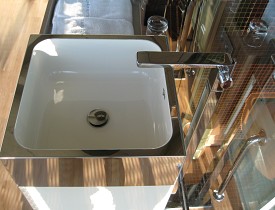5 Behind-the-Scenes Parts of Your Bathroom You Should Know About
 Bathrooms are pretty complicated little rooms and are subject to more than their fair share of building codes. This is primarily due to all the water that gets used in there, whether supplying it, getting rid of it or dealing with its effects. While few people need to know the finer points of bathroom design and construction, there are several elements you should be familiar with, some of which you probably never knew existed. This will serve you well if you ever have to deal with an emergency plumbing repair. Presenting ...
Bathrooms are pretty complicated little rooms and are subject to more than their fair share of building codes. This is primarily due to all the water that gets used in there, whether supplying it, getting rid of it or dealing with its effects. While few people need to know the finer points of bathroom design and construction, there are several elements you should be familiar with, some of which you probably never knew existed. This will serve you well if you ever have to deal with an emergency plumbing repair. Presenting ...
1. Pressure-Balancing Valve
A pressure-balancing valve is the standard type of anti-scald device found in most new shower faucets and many lavatory (sink) faucets. It’s required by building code in most areas for new bathrooms and remodels, and it’s a very good idea to retrofit one if you have young children or elderly residents in your home. A pressure-balancing valve automatically maintains the water temperature in the event of a change in the supply pressure. This keeps you from getting scalded in the shower if someone flushes the toilet or from getting a sudden blast of cold water if someone turns on the washer.
2. Thermostatic Valve
A thermostatic valve has the same purpose as a pressure-balancing valve, but it uses a thermostat-controlled device to mix the precise amount of hot and cold water that will maintain consistent water temperature without affecting the flow rate (pressure-type valves can significantly reduce the water flow when the supply pressure drops). Thermostatic valves can be used to control individual faucets or can be installed on the outlet side of a hot water heater to provide scald prevention to the whole house.
3. Vent Stack and Main Stack
You may have heard the terms vent stack, soil stack, main stack or main drain. These terms often are used interchangeably and sometimes inaccurately. For starters, a stack is a vertical pipe. Main stack describes the large, 4-inch pipe running from the basement, up through the house, and ending about a foot above the roof. All of the home’s drain lines feed into the main stack, which becomes the main drain (in the basement or crawlspace) that leads to the city sewer line or your septic tank. The section of the main stack that’s used for draining waste is known as the soil stack. The section above the highest drain connection is called the vent stack. Technically, “soil” pipes and stacks connect to toilets, while “waste” pipes and stacks do not.
4. Shutoff Valves
All fixtures that use water have some type of shutoff valve to control the flow of water to the fixture. The valve for a toilet is usually right below the tank, near where the water pipe comes through the wall. It has a little silver football-shaped handle on it. If your toilet is threatening to overflow, closing the shutoff valve is one way to stop the water. The shutoff valves for the lavatory faucets are under the sink.
5. P-Trap
The P-trap is the U-shaped section of drain pipe directly under the bathroom sink. If you drop something important (like a diamond earring) down the sink drain, check the P-trap. You remove it by loosening the big slip nut at each end of the trap. Be sure to place a bucket underneath, because the trap is full of water (very gross water). If your sink won’t drain, remove the P-trap and clean out the trap itself as well as the sections it’s connected to before you call a plumber.
Phil Schmidt is a Networx writer.
Updated August 26, 2018.
Looking for a Pro? Call us (866) 441-6648

Plumbing Average Costs
Plumbers Experiences

Gas Heater Repair To Prepare Our Garage For Winter

An Amazing, Reliable Plumber Answered My Call On New Year’s



